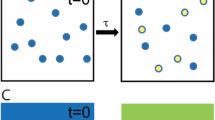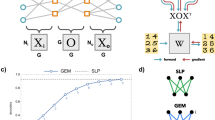Abstract
Three important systems, genes, the brain, and artificial intelligence (especially deep learning) have similar goals, namely, the maximization of likelihood or minimization of cross-entropy. Animal brains have evolved through predator-prey interactions in which maximizing survival probability and transmission of genes to offspring were the main objectives. Coordinate transformation for a rigid body necessary to win predator-prey battles requires a huge amount of matrix operations in the brain similar to those performed by a powerful GPU. Things (molecules), information (genes), and energy (ATP) are essential for using Maxwell’s demon model to understand how a living system maintains a low level of entropy. However, while the history of medicine and biology saw molecular biology and genetics disciplines flourish, the study of energy has been limited, despite estimates that >10% all human genes code energy-related proteins. Since there are a large number of molecular and genetic diseases, many energy-related diseases must exist as well. In addition to mitochondrial disease, common diseases such as neurodegenerative diseases, muscle diseases, cardiomyopathy, and diabetes are candidates for diseases related to cellular energy shortage. We are developing ATP enhancer, a drug to treat such diseases. I predict that in the future, the frontier of medicine and biology will involve energy and entropy, and the frontier of science will be about the cognitive processes that scientists’ brains use to study mathematics and physics. That will be understood by comparing the abilities that were necessary to survive battles between predators and prey during evolutionary history.
This is a preview of subscription content, access via your institution
Access options
Subscribe to this journal
Receive 12 print issues and online access
$259.00 per year
only $21.58 per issue
Buy this article
- Purchase on Springer Link
- Instant access to full article PDF
Prices may be subject to local taxes which are calculated during checkout


Similar content being viewed by others
References
Christian D. Big history: examines our past, explains our present, imagines our future. London: Dorling Kindersley Publishing; 2017.
Lane N .The Vital question: Why is life the way it is? London: Profile Books; 2015.
Oota S, Saitou S. Phylogenetic relationship of muscle tissues deduced from superimposition of gene trees. Mol Biol Evol. 1999;16:856–67.
Maloof A, Rose C, Beach R, et al. Possible animal-body fossils in pre-Marinoan limestones from South Australia. Nat Geosci. 2010;3:653–9.
Halder G, Callaerts P, Gehring WJ. New perspectives on eye evolution. Curr Opin Genet Dev. 1995;5:602–9.
Balavoine G, Adoutte A. The segmented urbilateria: a testable scenario. Integr Comp Biol. 2003;43:137–47.
Schrödinger E. What Is Life?: The physical aspect of the living cell. Cambridge: Cambridge University Press; 1944.
Bishop CM. Pattern recognition and machine learning. New York: Springer; 2006. 235.
Barnett L, Bossomaier T. Transfer entropy as a log-likelihood ratio. Phys Rev Lett. 2012;109:138105.
Dawkins R. The selfish gene. London: Oxford Press; 1976.
International Human Genome Sequencing Consortium. Finishing the euchromatic sequence of the human genome. Nature. 2004;431:931–45.
Azevedo FA, Carvalho LR, Grinberg LT, et al. Equal numbers of neuronal and nonneuronal cells make the human brain an isometrically scaled-up primate brain. J Comp Neurol. 2009;513:532–41.
Friston K. A theory of cortical responses. Philos Trans R Soc Lond B Biol Sci. 2005;360:815–36.
Silver D, Hubert T, Schrittwieser J, et al. A general reinforcement learning algorithm that masters chess, shogi, and Go through self-play. Science. 2018;362:1140–4.
Kamatani N. Six-layer structure for genomics and its applications. J Hum Genet.2016;61:267–70.
Calkin MG. Lagrangian and Hamiltonian mechanics. Singapore: World Scientific; 1996.
McCarthy JM. Introduction to theoretical kinematics. Cambridge: MIT Press; 1990.
Hall JD, Carr NA, Hart JC. Cache and bandwidth aware matrix multiplication on the GPU. UIUC Technical Report UIUCDCSR-2003-2328; 2003.
Brillouin L. Maxwell’s demon cannot operate: Information and entropy. J Appl Phys. 1951;22:334–7.
Theunissen TEJ, Nguyen M, Kamps R, et al. Whole exome sequencing is the preferred strategy to identify the genetic defect in patients with a probable or possible mitochondrial cause. Front Genet. 2018;9:400. https://doi.org/10.3389/fgene.2018.00400.
Johnson SA, Hunter T. Kinomics: methods for deciphering the kinome. Nat Methods. 2005;2:17–25.
George AJ, Hoffiz YC, Charles AJ, Zhu Y, Mabb AM. A comprehensive atlas of E3 ubiquitin ligase mutations in neurological disorders. Front Genet. 2018;9:29. https://doi.org/10.3389/fgene.2018.00029.
Koene S, van Bon L, Bertini E, Jimenez-Moreno C, van der Giessen L, de Groot I, et al. Outcome measures for children with mitochondrial disease: consensus recommendations for future studies from a Delphi-based international workshop. J Inherit Metab Dis. 2018;41:1267–73.
Alston CL, Rocha MC, Lax NZ, Turnbull DM, Taylor RW. The genetics and pathology of mitochondrial disease. J Pathol. 2017;241:236–50.
Rango M, Bozzali M, Prelle A, Scarlato G, Bresolin N. Brain activation in normal subjects and in patients affected by mitochondrial disease without clinical central nervous system involvement: a phosphorus magnetic resonance spectroscopy study. J Cereb Blood Flow Metab. 2001;21:85–91.
Karaa A, Goldstein A. The spectrum of clinical presentation, diagnosis, and management of mitochondrial forms of diabetes. Pediatr Diabetes. 2015;16:1–9.
Montaigne D, Pentiah AD. Mitochondrial cardiomyopathy and related arrhythmias. Card Electrophysiol Clin. 2015;7:293–301.
Orr AL, Kim C, Jimenez-Morales D, Newton BW, Johnson JR, Krogan NJ, et al. Neuronal apolipoprotein E4 expression results in proteome-wide alterations and compromises bioenergetic capacity by disrupting mitochondrial function. J Alzheimers Dis. 2019. https://doi.org/10.3233/JAD-181184.
Terada T, Obi T, Bunai T, et al. In vivo mitochondrial and glycolytic impairments in patients with Alzheimer disease. Neurology. 2020;94:e1592–e1604.
Wilkins HM, Morris JK. New therapeutics to modulate mitochondrial function in neurodegenerative disorders. Curr Pharm Des. 2017;23:731–52.
Short KR, Bigelow ML, Kahl J, Singh R, Coenen-Schimke J, Raghavakaimal S, et al. Decline in skeletal muscle mitochondrial function with aging in humans. Proc Natl Acad Sci USA. 2005;102:5618–23.
Surampalli A, Khare M, Kubrussi G, et al. Psychological impact of predictive genetic testing in VCP Inclusion body myopathy, Paget disease of bone and frontotemporal dementia. J Genet Couns. 2015;24:842–50.
Mori F, Tanji K, Toyoshima Y, et al. Valosin-containing protein immunoreactivity in tauopathies, synucleinopathies, polyglutamine diseases and intranuclear inclusion body disease. Neuropathology. 2013;33:637–44.
Yi L, Kaler SG. Interaction between the AAA ATPase p97/VCP and a concealed UBX domain in the copper transporter ATP7A is associated with motor neuron degeneration. J Biol Chem. 2018;293:7606–17.
Benaroudj N, Zwickl P, Seemu¨ler E, et al. ATP hydrolysis by the proteasome regulatory complex PAN serves multiple functions in protein degradation. Mol Cell. 2003;11:69–78.
Johnson TA, Jinnah HA, Kamatani N. Shortage of cellular ATP as a cause of diseases and strategies to enhance ATP. Front Pharmacol. 2019;10:98.
Kamatani N, Kushiyama A, Toyo-Oka L, Toyo-Oka T. Treatment of two mitochondrial disease patients with a combination of febuxostat and inosine that enhances cellular ATP. J Hum Genet. 2019;64:351–3.
Kamatani N, Hashimoto M, Sakurai K, Gokita K, Yoshihara J, Sekine M, et al. Clinical studies on changes in purine compounds in blood and urine by the simultaneous administration of febuxostat and inosine, or by single administration of each. Gout Nucleic Acid Metab. 2017;41:171–81. https://www.jstage.jst.go.jp/article/gnam/41/2/41_171/_pdf/-char/ja.
Watanabe H, Hattori T, Kume A, Misu K, Ito T, Koike Y, et al. Improved Parkinson’s disease motor score in a single-arm openlabel trial of febuxostat and inosine. Medicine. 2020; in press.
Acknowledgements
I thank Dr. Todd A. Johnson for correcting English in the present paper.
Author information
Authors and Affiliations
Corresponding author
Ethics declarations
Conflict of interest
NK is employed and paid by StaGen Co. Ltd.
Additional information
Publisher’s note Springer Nature remains neutral with regard to jurisdictional claims in published maps and institutional affiliations.
Rights and permissions
About this article
Cite this article
Kamatani, N. Genes, the brain, and artificial intelligence in evolution. J Hum Genet 66, 103–109 (2021). https://doi.org/10.1038/s10038-020-0813-z
Received:
Revised:
Accepted:
Published:
Issue Date:
DOI: https://doi.org/10.1038/s10038-020-0813-z



